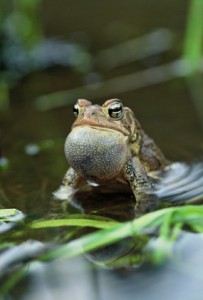The storms of the previous day had moved eastward, leaving in their wake flooded farm fields and saturated roadside wetlands. At dusk, we loaded the Ford Escort wagon and headed south. We bumped along the maze of farm roads intent upon listening for croaks and snores in the night. At one roadside wetland, I heard my first congress of Spadefoot toads. The sound was deafening, invoking everything that a “congress of snoring toads” brings to mind. Around the corner, in a low spot of a corn field, a lone Spadefoot toad called for a mate; he was joined by a rather enthusiastic Copes Gray tree frog and several chorus frogs. The congress down the road provided a rolling bass to these more melodic anurans.
Wetlands exist in many different shapes and sizes and in many different geographies: coastal margins, mountain valleys, beaches and rocky shores, estuarine wetlands where tidal saltwater and freshwater mix, and inland wetlands. Some of them are ephemeral, some of them permanent. Wetlands serve many different functions, from providing habitat and food for plants and animals to offering protection from floods and maintaining water quality. One acre of one-foot deep wetland is estimated to hold 330,000 gallons of water. Coastal wetlands are important for reducing storm erosion by decreasing tidal surge and buffering the wind. In the US alone, this benefit has an estimated value of $23.2 billion dollars each year.
Many wetlands are important for maintaining water quality. Wooded riparian wetlands next to streams and ponds can reduce pollution and trap sediment, removing substances such as nitrogen, phosphorus and pesticides from agricultural runoff before they reach surface waters. Removing these compounds from agricultural runoff can help prevent the development of smelly, eutrophic lakes and toxic algal blooms. The 2014 Lake Erie bloom affected drinking water for the city of Toledo, forcing residents to turn to bottled water (1).
The water purification functions of wetlands depend upon several factors, including the variety of vegetation and microbial community living within. The microbes found in wetlands are responsible for catalyzing most of the chemical transformations that clear nitrogen, phosphorus, pesticides and other compounds from the water before it returns to the ground water or enters nearby surface water. In fact, wetlands are so effective at purifying water that artificial wetlands are being created to filter and treat waste water and water polluted from mining activities.
Monitoring microbial populations is an important aspect of monitoring water quality. The presence of unwanted bacteria could indicate that water quality is jeopardized. This kind of field work benefits from quick, portable assays. Traditionally, microbiologists obtained water samples and returned to the laboratory to culture and count organisms in a process called heterotrophic plate count (HPC). The testing process, however, takes at least 24 hours. This delay prevents quick action, such as closing off recreational waters to prevent waterborne illnesses. It could also mean missing the time-critical window to restore beneficial microbes in an ecosystem.
Now, there’s a faster way to detect live microbe activity. This new method measures the concentration of a tiny molecule called adenosine triphosphate (ATP)—the energy currency of all living cells. The level of ATP in a water sample directly correlates with the amount of active biomass in the sample. To measure ATP levels, a luciferase enzyme generates luminescence upon reacting with ATP.
In 2014, researchers at UCLA tested an ATP assay for detecting fecal indicator bacteria (FIB) with the goal of monitoring beach wetlands to protect swimmers and surfers. This method called covalently linked immunogenic separation/adenosine triphosphate technique (COV-IMS/ATP), was compared to traditional culture techniques and more elaborate assays such as qPCR. In this method, magnetic beads are covalently attached to antibodies specific for FIB. The beads are mixed with a water sample where they capture the targeted bacteria. The FIB is lysed and an ATP-dependent luciferase reaction is used to quantitate the FIB present in the sample. In this study, the researchers used our BacTiter-Glo™ Microbial Cell Viability Assay and the GloMax® 20/20 Luminometer. Results from the pilot study indicate that this highly portable assay compares favorably to the traditional methods, with the advantage of obtaining results in about an hour. In addition, the COV-IMS/ATP assay doesn’t require the same scientific expertise as the qPCR method, making it accessible to a wider community of individuals who might be interested in water-quality monitoring (2).
More recently, we developed a new kit based on the BacTiter-Glo™ ATP bioluminescent technology but designed specifically for water samples. The Water-Glo™ Kit detects all live microbes and can be used to test freshwater, seawater and wastewater. The assay involves capturing biomass on a filter surface, extracting ATP from the captured biomass, adding detection reagent to generate a luminescent signal, then detecting the signal with a luminometer. The whole process takes minutes instead of hours.
In the future, freshwater sources and growing populations will continue to collide. Understanding and protecting wetlands becomes increasingly important for maintaining clean water sources for natural habitats, human consumption and recreation. Faster and more sensitive methods for monitoring the microbial communities of wetlands and other water sources are crucial for protecting our environment and preventing waterborne illness. Hopefully, we will continue to hear chorus of frogs and other wetland wildlife for generations to come.
References
- Arenschield, L. (2014) Curbing phosphorus would quickly slash algae in Lake Erie. The Columbus Dispatch. [Internet: http://www.dispatch.com/content/stories/local/2014/08/19/Lake-Erie-algae-phosphorus-runoff-water-quality.html accessed 2/1/2015]
- Zimmer-Faust, A.G. et al. (2014) Performance and Specificity of the Covalently Linked Immunomagnetic Separation-ATP Method for Rapid Detection andEnumeration of Enterococci in Coastal Environments Envir. Micro. 80, 2705–14.
Michele Arduengo
Latest posts by Michele Arduengo (see all)
- The Casual Catalyst: Science Conversations and Cafes - July 18, 2024
- Cancer Moonshot: Solving Tough Problems - May 28, 2024
- Automated Sampling and Detection of ToBRFV: An Emerging Tomato Virus - April 25, 2024


